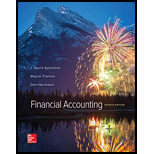
Financial Accounting
4th Edition
ISBN: 9781259307959
Author: J. David Spiceland, Wayne M Thomas, Don Herrmann
Publisher: McGraw-Hill Education
expand_more
expand_more
format_list_bulleted
Concept explainers
Question
Chapter D, Problem 7RQ
To determine
To Indicate: The two categories of the investments in equity securities under the fair value method.
Expert Solution & Answer
Want to see the full answer?
Check out a sample textbook solution
Students have asked these similar questions
4 POINT
Diane Fabrics has a magnitude of operating leverage of 2 at a sales level of $320,000. If sales increase by 10%, profits (net income) will increase by____.
The predetermined overhead rate based units produced us (rounded fo the nearest penny?:
Chapter D Solutions
Financial Accounting
Ch. D - Prob. 1RQCh. D - 2.How can an investor benefit from an equity...Ch. D - 3.How might investing activity for a company that...Ch. D - Provide an example of an equity investment in...Ch. D - Prob. 5RQCh. D - Prob. 6RQCh. D - Prob. 7RQCh. D - Prob. 8RQCh. D - Prob. 9RQCh. D - 10.When using the fair value method, we adjust the...
Ch. D - Prob. 11RQCh. D - 12.Under what circumstances do we use the equity...Ch. D - Prob. 13RQCh. D - Prob. 14RQCh. D - Prob. 15RQCh. D - 16.What is the flip side of an investment in debt...Ch. D - Prob. 17RQCh. D - Prob. 18RQCh. D - Prob. 19RQCh. D - Prob. 20RQCh. D - Prob. D.1BECh. D - Prob. D.2BECh. D - Prob. D.3BECh. D - Prob. D.4BECh. D - Prob. D.5BECh. D - Prob. D.6BECh. D - Prob. D.7BECh. D - Prob. D.8BECh. D - Prob. D.9BECh. D - Prob. D.10BECh. D - Prob. D.11BECh. D - Prob. D.12BECh. D - Prob. D.1ECh. D - Prob. D.2ECh. D - Prob. D.3ECh. D - Prob. D.4ECh. D - Prob. D.5ECh. D - Prob. D.6ECh. D - Prob. D.7ECh. D - Prob. D.8ECh. D - Prob. D.9ECh. D - Prob. D.10ECh. D - Prob. D.11ECh. D - Prob. D.1APCh. D - Prob. D.2APCh. D - Prob. D.3APCh. D - Prob. D.4APCh. D - Prob. D.1BPCh. D - Prob. D.2BPCh. D - Prob. D.3BPCh. D - Prob. D.4BP
Knowledge Booster
Learn more about
Need a deep-dive on the concept behind this application? Look no further. Learn more about this topic, accounting and related others by exploring similar questions and additional content below.Similar questions
- Neptune Manufacturing assigns overhead costs to jobs on the basis of 140% of direct labor costs. The job cost sheet for Job 723 includes $32,600 in direct materials cost and $18,500 in direct labor cost. A total of 2,500 units were produced in Job 723. Required: a. What is the total manufacturing cost assigned to Job 723? b. What is the unit product cost for Job 723?arrow_forwardOn October 1, Year 6, Whitney Company declared a property dividend payable in the form of marketable equity securities classified as "trading" for financial accounting purposes. The marketable equity securities will be distributed to the common stockholders on December 1, Year 6. The investment in equity securities originally cost Whitney $510,000 on August 1, Year 6. The investment's fair value on various dates is as follows: October 1, Year 6 $530,000 December 1, Year 6 535,000 December 31, Year 6 540,000arrow_forwardAn item of equipment owned by Bruno Manufacturing cost $180,000 and had an estimated use of 90,000 hours. During the first 3 years, the equipment was used for 15,000, 19,000, and 12,000 hours. The equipment has an estimated life of 8 years and an estimated salvage value of $30,000. Required: Determine the depreciation for each of the 3 years using the units of production method.arrow_forward
arrow_back_ios
SEE MORE QUESTIONS
arrow_forward_ios
Recommended textbooks for you
 Cornerstones of Financial AccountingAccountingISBN:9781337690881Author:Jay Rich, Jeff JonesPublisher:Cengage Learning
Cornerstones of Financial AccountingAccountingISBN:9781337690881Author:Jay Rich, Jeff JonesPublisher:Cengage Learning Auditing: A Risk Based-Approach (MindTap Course L...AccountingISBN:9781337619455Author:Karla M Johnstone, Audrey A. Gramling, Larry E. RittenbergPublisher:Cengage Learning
Auditing: A Risk Based-Approach (MindTap Course L...AccountingISBN:9781337619455Author:Karla M Johnstone, Audrey A. Gramling, Larry E. RittenbergPublisher:Cengage Learning



Cornerstones of Financial Accounting
Accounting
ISBN:9781337690881
Author:Jay Rich, Jeff Jones
Publisher:Cengage Learning


Auditing: A Risk Based-Approach (MindTap Course L...
Accounting
ISBN:9781337619455
Author:Karla M Johnstone, Audrey A. Gramling, Larry E. Rittenberg
Publisher:Cengage Learning